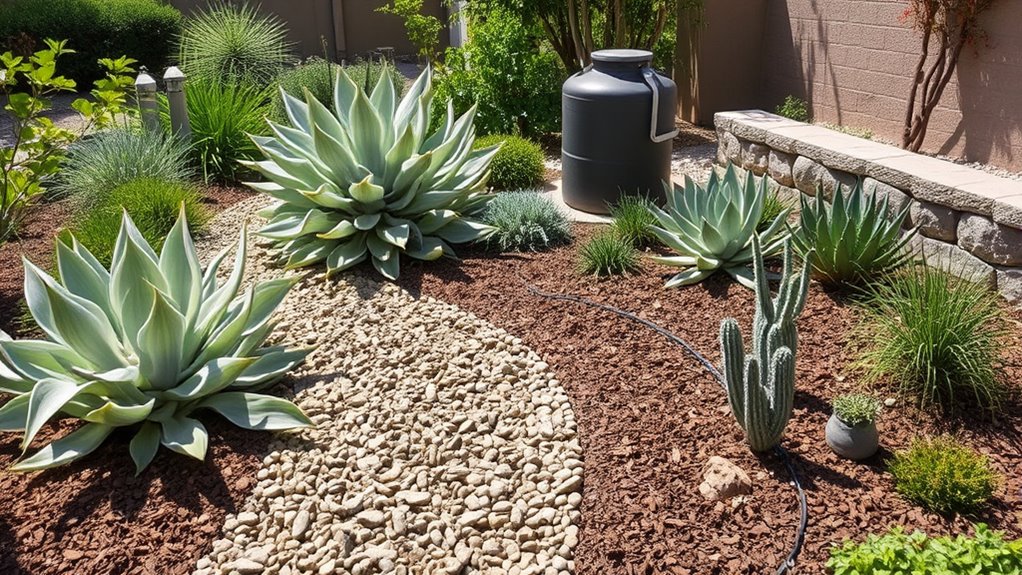To drought-proof your garden, focus on water-efficient landscaping techniques like selecting drought-tolerant native plants and grouping them for efficient watering. Mulch your soil to conserve moisture and regulate temperature, while using drip irrigation systems with timers to deliver water directly where needed. Incorporate hardscapes like rocks and pathways to reduce irrigation zones. Following these strategies helps create a resilient, low-maintenance garden that thrives despite dry conditions; keep exploring to discover even more effective hacks.
Key Takeaways
- Use drought-tolerant, native plants grouped together to reduce water needs and maintenance.
- Apply mulch to soil to retain moisture, regulate temperature, and suppress weeds.
- Install drip irrigation with timers set for early morning or late evening to minimize evaporation.
- Incorporate hardscapes like rocks and gravel to create visually appealing, low-water areas.
- Design with strategic plant placement and soil improvements to enhance water retention and garden resilience.

Maintaining a beautiful garden doesn’t have to be overwhelming if you apply a few smart landscaping hacks. One of the most effective ways to do this is by embracing drought-proof landscaping, which conserves water while keeping your garden vibrant. The key is understanding xeriscaping principles—an approach designed specifically for water efficiency. These principles encourage you to plan your landscape around the natural climate, reducing or eliminating the need for supplemental watering. By selecting drought-tolerant plants, you create a resilient garden that thrives even during dry spells.
Start by evaluating your local climate and soil conditions. Knowing what plants naturally thrive in your area allows you to choose species that are adapted to the environment, reducing water consumption. Drought-tolerant plants, such as succulents, lavender, and certain ornamental grasses, require minimal irrigation once established. These plants have evolved to survive with less water, making them ideal for xeriscaping. When planting, group drought-tolerant species together, which simplifies watering routines and ensures that each plant receives the appropriate moisture levels.
Assess your climate and soil to select native, drought-tolerant plants that thrive with minimal watering.
Incorporate mulching into your landscape design. Mulch helps retain soil moisture, suppress weeds, and regulate soil temperature. Organic mulches like bark or straw also improve soil quality over time. When combined with drought-tolerant plants, mulching substantially reduces your watering needs, making your garden more sustainable and easier to maintain.
Efficient irrigation methods are also vital. Drip irrigation systems deliver water directly to the roots, minimizing waste caused by evaporation or runoff. Set timers to water early in the morning or late in the evening when evaporation rates are lower. Keep an eye on weather patterns; during rainy periods, reduce or pause watering to prevent over-saturation.
Designing your landscape with xeriscaping principles in mind also involves thoughtful layout choices. Use hardscapes—like rocks, gravel, or pathways—to reduce the area that needs watering. These elements add visual interest and help define space, all while conserving water.
Finally, maintain your drought-proof garden by regularly inspecting plants for signs of stress and adjusting watering schedules accordingly. With the right combination of drought-tolerant plants, strategic planning, and efficient watering techniques, you can create a stunning garden that withstands dry conditions without demanding excessive care or water. Incorporating native plants can further enhance water efficiency by supporting local ecosystems and reducing maintenance needs. This approach not only saves resources but also guarantees your garden remains lush and healthy year-round, regardless of drought challenges.
Frequently Asked Questions
Which Drought-Resistant Plants Are Best for My Climate Zone?
You should focus on native species suited to your climate zone for the best drought resistance. These plants naturally thrive with less water and are adapted to local conditions. Incorporate xeriscape principles by selecting hardy, drought-tolerant plants that require minimal irrigation. By choosing native species, you’ll create a sustainable, low-maintenance garden that conserves water and supports local ecosystems. Always check your specific zone to guarantee the plants you select will flourish.
How Often Should I Water My Drought-Proof Garden?
Imagine your garden as a resilient oasis, thriving with minimal water. You should water your drought-proof garden early in the morning, following xeriscaping principles, which emphasize deep, infrequent watering. For drought-tolerant trees, watering once every two to three weeks is sufficient, allowing roots to grow deep and access underground moisture. Adjust based on rainfall and soil moisture, ensuring your plants stay healthy without overwatering.
Can I Create a Drought-Resistant Lawn Alternative?
You can definitely create a drought-resistant lawn alternative by adopting xeriscape design and selecting native plants. These practices reduce water needs and thrive in your local climate. Opt for drought-tolerant grasses or ground covers, and incorporate native plants that withstand dry conditions. By doing so, you’ll enjoy a lush, low-maintenance landscape that conserves water and looks beautiful year-round. It’s a smart, eco-friendly way to upgrade your garden while saving resources.
What Mulch Types Retain Moisture Best?
You’ll find that organic mulches like wood chips and straw retain moisture best, especially when combined with efficient irrigation systems. These mulches slow evaporation and keep soil moist longer. Incorporate compost techniques to enrich the mulch, improving water retention. Regularly applying these mulches helps your garden stay hydrated, reducing water use. Pairing the right mulch with smart irrigation guarantees your plants stay healthy and drought-resistant, saving water and effort.
How Do I Maintain Soil Health With Less Water?
Maintaining soil health with less water is like nurturing a delicate balance. You should incorporate soil amendments and composting techniques to enrich your soil naturally. Regularly add organic matter to improve moisture retention and structure, making your garden more resilient. Additionally, avoid overwatering, and use mulch to reduce evaporation. These practices help your soil stay healthy and productive, even during dry spells, ensuring your garden thrives with less water.
Conclusion
By applying these drought-proof landscaping hacks, you’ll turn your garden into a resilient oasis that withstands dry spells. Think of your garden as a sturdy ship sailing smoothly through storms—you’re the captain steering it wisely. With smart water-saving techniques and drought-resistant plants, you’ll enjoy a lush, thriving garden without draining your resources. So, take charge today and let your garden flourish like a well-tended masterpiece, even in the face of droughts.









